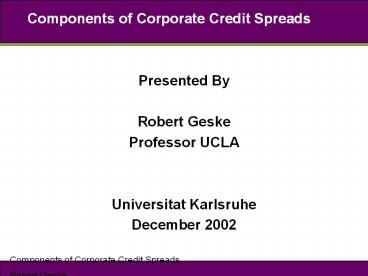Components of Corporate Credit Spreads PowerPoint PPT Presentation
Title: Components of Corporate Credit Spreads
1
Components of Corporate Credit Spreads
- Presented By
- Robert Geske
- Professor UCLA
- Universitat Karlsruhe
- December 2002
2
Basel/BIS Concerns
- Market Risk
- Credit Risk (Default?)
- What are the similarities?
- What are the differences?
3
Credit Exposure is
- Current Future Market Credit Risk
- Credit Spreads
- Composition?
4
Credit Spreads
- Risk Components?
- Default Risk
- Recovery Risk
- Tax Risk
- Jump Risk
- Liquidity Risk
- Market Risk
5
Literature
- Merton (1974)
- Black Cox (1976), Geske (1977)
- Longstaff Schwartz (1995), Leland Toft (1996)
- Colin-Dufresne, Goldstein, et al (2000)
- Eom, Helwege, Huang (2002)
- Huang Huang (2002)
- Duffie Lando (2001), Jarrow Turnbull (1995)
- Delianedis Geske (1998), KMV, Leland (2002)
6
Modeling Firm Dynamics Payouts
7
Valuation
8
Valuation
9
Recovery Default Costs
10
Recovery Default Costs
11
Default Spread
12
Taxes
13
Jumps
14
Residual Spread
- CS DS RS
15
Table 1 Panel A With Asian Crisis
Table 1 - Credit and Default Spreads Reported in
basis points are the averages of the medians,
quartiles, and standard deviations for each
rating category with and without the Fall 1998
Asian/LTC crisis. Firms indicates the average
number of firms per month during this
period. Panel A With Asian/LTC Crisis
16
Table 1 Panel B Without Asian Crisis
Table 1 - Credit and Default Spreads Reported in
basis points are the averages of the medians,
quartiles, and standard deviations for each
rating category with and without the Fall 1998
Asian/LTC crisis. Firms indicates the average
number of firms per month during this period.
Panel B Without Asian/LTC Crisis
17
Table 2 Panel A With Asian Crisis
Table 2 - Residual Spreads Reported in basis
points are the averages of the medians,
quartiles, and standard deviations of the
residual spreads for each investment grade rating
category with and without including the Asian/LTC
Crisis of the Fall of 1998. Panel A With
Asian/LTC Crisis
18
Table 2 Panel B Without Asian Crisis
Table 2 - Residual Spreads Reported in basis
points are the averages of the medians,
quartiles, and standard deviations of the
residual spreads for each investment grade rating
category with and without including the Asian/LTC
Crisis of the Fall of 1998.
Panel B Without Asian/LTC Crisis
19
Table 3 Summary of SpreadsFor Diffusion
Models
Table 3 - Summary of Spreads for Diffusion
Models
? Spreads are in basis points. Default spread
is calculated with the Merton model with accrued
dividends and interest payments and a 45 loss
associated with default. The model is calibrated
such that the equity price and volatility are
matched exactly. The default spread is the
average over time of the cross-sectional medians
for firms in each rating class. Credit spread
data is from CMS for matched duration. Residual
spread is the difference.
20
Table 4 Residual, Credit and Default Spread
Correlations
21
Table 4 Residual, Credit and Default Spread
Correlations
22
Table 4 Residual, Credit and Default Spread
Correlations
23
Table 5Effects of Fractional Recovery Rates and
Taxes On Default Spreads
Nov 1991 - Dec 1998
24
Table 5Effects of Fractional Recovery Rates and
Taxes On Default Spreads
Nov 1991 - Dec 1998
Spreads are in basis points.
Default spread is calculated with the Merton
model with accrued dividends and interest
payments and a variable recovery associated with
default. The model is calibrated such that the
equity price and volatility are matched exactly.
The default spread is the average over time of
the cross-sectional medians for firms in each
rating class. Credit spread data is from CMS for
matched duration. Residual spread is the
difference.
25
Table 6 Jump-Diffusion ModelsNecessary Jump
Parameters and Volatility
Assess the impact on default spreads
of a jump-diffusion model instead of a pure
diffusion model for the firm value. Default
spreads are estimated with a jump-diffusion
process for the firm value following Merton
(1976, 1979). Jumps are assumed distributed
lognormal with zero mean. The observed stock
volatility is reported. Base case is the
Merton model with no jumps and the default spread
is much less than the credit spread.
Next the base case parameters are used and a jump
process is added (Additive). Jump magnitude is
increased until the default spreads are equal to
the credit spreads. The frequency of the jumps
is annual. Table shows the necessary total firm
volatility which is about the same for the
necessary jump scenarios.
26
Table 7 Residual SpreadRegression Analysis of
Components
Regressions of changes in the residual
spread on changes in a measure of trading volume,
the level of risk free rate, changes in the slope
of term premium, US equity market return, and
volatility as changes in the squared US equity
market return, and the adjusted R2 are reported.
The adjusted R2 is much higher (45-60) when
explaining the level on the residual spread.
27
Components of Corporate Credit Spreads
- Thank You

